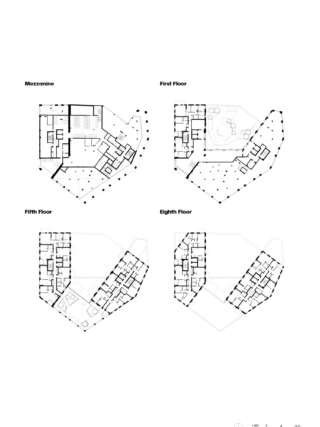Alison Brooks Architects’ landmark, mixed-use residential-led development in Tottenham Hale, north London, is rooted in place and community.
Designed by Alison Brooks Architects, One Ashley Road is landmark mixed-use development that forms the gateway to London’s Tottenham Hale redevelopment, Heart of Hale. Located near the Walthamstow Wetlands and Lea Valley waterways, the scheme forms part of a large-scale transformation of a post-industrial, traffic-dominated transport hub into a characterful, diverse and walkable neighbourhood. The 20,600 square-metre project comprises a pair of residential towers accommodating 183 units and planned around a courtyard block, three levels of retail and incubator office spaces, as well as roof gardens and new public realm.
Conceived as the ‘front door’ to the Heart of Hale masterplan, the scheme’s animated silhouette and colonnaded base (situated opposite the Tottenham Hale transport hub) creates a memorable new identity. The development also references the area’s industrial heritage, particularly the adjacent Berol House, which was once part of the Eagle Pencil Company Factory, with a ‘carved’ and animated perimeter block. This is expressed through a distinctive, faceted form with an emphasis on verticality. With a rich orange brick outer skin and a shimmering metal inner skin, the design is inspired by the graphic colours and hexagonal forms of the iconic Berol Eagle Pencil. These have been translated formally as abstract surface patterns within the architecture of the building.
Stepped massing creates a secluded residents’ podium garden and co-working space at third-floor level and a south-facing communal roof garden at seventh-floor level. The latter overlooks the new square, while the mid-rise scale softens the transition between the tall elements and the public realm. In contrast to the smooth terracotta exterior, the internal elevations incorporate faceted metal cassette panels, which reflect light into the block interior.
The presence of two Victoria line tunnels beneath the site resulted in a stepped-base massing block, which recesses to the north to provide communal green terraces. These outdoor spaces provide residents with access to air, light, and panoramic views. The gardens and hexagonal terrace weave green space throughout the project, creating communal destinations for residents to get together, socialise, and relax in a variety of quiet, secluded locations.
Achieving BREEAM Very Good, the scheme addresses both the Tottenham Green Grid (Policy AAP9; TAAP) and the Council’s Open Spaces Strategy. Operational carbon savings exceed the Greater London Authority’s targets by almost 50 per cent. This high level of environmental performance is achieved through the building’s connection to a District Energy Network (DEN), which provides the base heat load for the entire development and reduces reliance on traditional heating sources.
Other environmental measures include solar photovoltaic panels, smart metering, and energy management software, enabling efficient monitoring and optimisation of energy usage throughout the building’s lifecycle. Embracing a ‘lean, clean and green’ approach, the complex also incorporates a range of passive design features and a ‘fabric first’ strategy to reduce its energy demand.
Additional Images
Credits
Architect
Alison Brooks Architects
Structural engineer
Whitby Wood
Services engineer
Sweco
Interior architect
Conran and Partners
Main contractor
Galliford Try
Contractor delivery architect
KDS Architects
Client
Related Argent






































